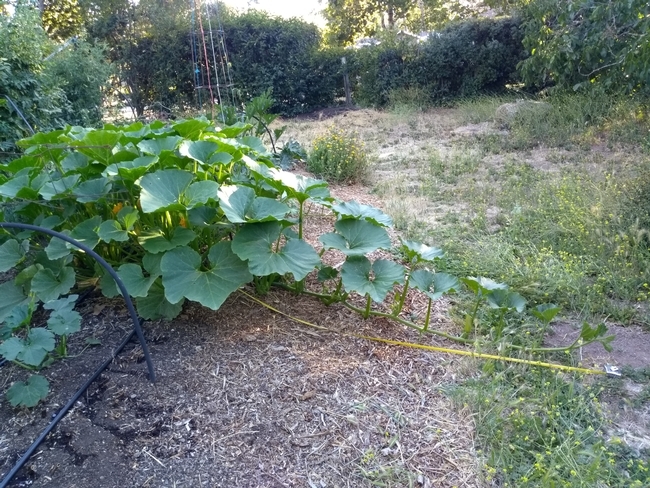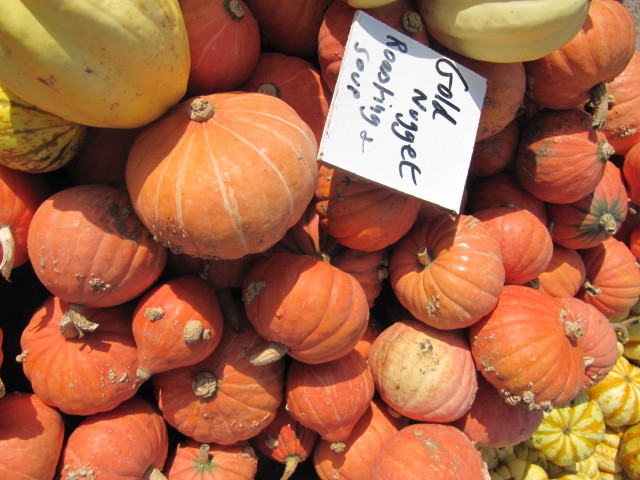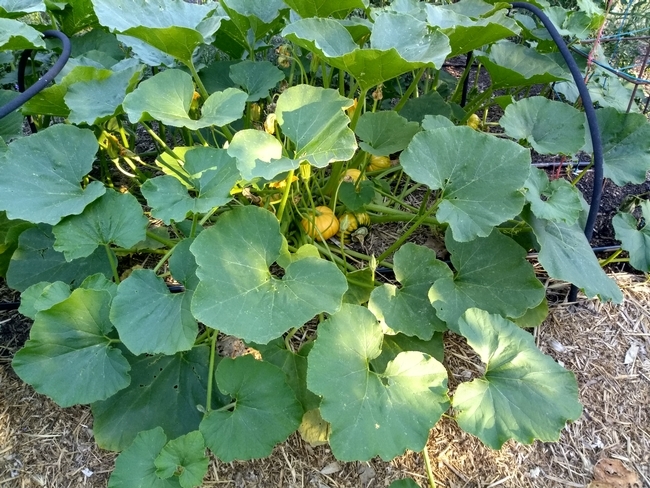
It's hard to believe that zucchini and pumpkins belong to the same plant family, but both are part of the cucurbit, or gourd, family of vegetables. Summer squash, such as zucchini and yellow crookneck, ripen throughout the summer and are best eaten when they are young, when their skins are tender and the seeds small. Winter squash are also planted in the spring, but they mature throughout the summer and are harvested only when they are mature, when their skins are hard and the seeds mature. They can be stored for weeks or months, right on through the winter, hence the name “winter” squash.
The Napa Master Gardeners Field Test Committee set out to try three different winter squash varieties. One problem for many gardeners is the lack of space for these sprawling long-vined vegetables. We searched the seed catalogs for varieties that promised to be space savers, either short-vining or bush varieties. We picked two that were described as bushes. These are bred to produce small squashes. One was Kindred Buttercup, which was a long-time favorite of one of our members. Another small fruit producer was called Gold Nugget. The third variety, Sweet Mama, was not advertised as a small squash, but the seed packet claimed it was a short-vined space saver.

The other two varieties were space savers, because they were true bushes and they produced small squash. Both varieties produced an average of nine squash per hill (2-3 plants) with an average weight of one pound. The Kindred Buttercup seed packet claims the average size is 3-5 pounds. It is possible that our results were not typical, due to the severe drought we were battling. It is an attractive gold-orange orb that makes a pretty addition to the table.
Gold Nugget's small size was consistent with the seed packet description, which was 1-1.5 pounds. It was the least popular of the three. We had some failures with its germination, and for some of us it failed to thrive. Most of us felt it was too small to warrant the trouble of growing it. It made a pretty table decoration, but the flesh was not thick enough to provide much to eat.

We planted in early May, directly in the ground or raised beds. Harvest ranged from early August to late October. Squash is ripe when the rind is hard and difficult to pierce with your fingernail. When harvesting, always leave an inch or two of stem attached to the squash. There should be no damage to the rind. Squash should be cleaned and dried before storing. These measures prevent bacteria from entering the fruit.
Winter squash are best stored at 55-59°F and can last 2 to 6 months depending on the variety. Cucurbita pepo types such as acorn, spaghetti, and delicata are best eaten in the fall. Cucurbita maxima types such as hubbard, buttercup, and kabocha squash are best eaten in December/January. Cucurbita moschata types such as butternut will store the longest.
All three varieties in our trial are in the C.maxima family. For optimal flavor, this type of squash requires a curing period to convert some of the starch to sugar. I cooked some of the Sweet Mama shortly after harvest and found it bland and starchy. After allowing time for curing, I tried it again, and it was rich and sweet.
Kindred Buttercup won a blind taste test of the three squashes. The small size is convenient for a meal for two. My favorite was the kabocha variety, Sweet Mama. It is harder to cut, but its size provides a thick layer of dense, tasty fruit. It can be used in place of pumpkin for a pie.
These types of squash should be kept in a warm, airy place for 10-14 days before transferring to a cool dark place for longer storage. The larger varieties generally keep longer than the smaller ones.
If you want to extend the enjoyment of your garden produce, winter squash is delicious, easy to grow, and requires no special equipment to preserve.
Napa Master Gardeners are available to answer garden questions by email: mastergardeners@countyofnapa.org. or phone at 707-253-4143. Volunteers will get back to you after they research answers to your questions.
Information about squash: https://vric.ucdavis.edu/veg_info_crop/pumpkinsandsquash.htm
Visit our website: napamg.ucanr.edu to find answers to all of your horticultural questions.
Photo credits: Pat Hitchcock; Gold Nugget squash; Leonora Enking from West Sussex, England, CC BY-SA 2.0